Stuffed cabbage leaves, also known as holishkes or prokes, may just be the ultimate comfort food. A slowly cooked, savory cold-weather dish, stuffed cabbage is a classic, and many families seem to have their own way of making it. Today, I’m sharing a traditional Jewish stuffed cabbage recipe that’s a favorite for my family.
Stuffed cabbage is one of those nostalgic dishes that brings back memories of family, tradition, and comfort. While I didn’t grow up with a Jewish “bubbe” to teach me her version, I’ve spent years diving into the dish’s history and testing recipes from Polish and Israeli friends, classic cookbook authors like Joan Nathan, and even 2nd Avenue Deli. I’ve made it sweet with raisins and preserves, tangy with sauerkraut and tomato, and everything in between.
My favorite take? A savory, well-seasoned filling with a slightly tart sauce. It’s less sweet than some versions, but packed with flavor. This is the version my husband loves, and the one readers return to again and again.
Everyone’s bubbe has her own way, and that’s the beauty of Jewish cooking. Below, I’m sharing my version, along with a step-by-step video and all my tips and tricks. Perfect for cozy fall and winter meals, this dish is naturally gluten-free (when using certified GF products), high in protein, and full of fiber. For a quicker take, check out my Unstuffed Cabbage recipe.
Ingredients and Notes
Please be sure to scroll down to the recipe card for the complete details!
-
- Cabbage – I prefer to use green cabbage for this recipe. 1 large head of cabbage is typically enough, but you may want to grab a second just in case.
-
- Protein – I like to use a mixture of ground beef and ground chicken, but you can choose one or the other, if preferred. Feel free to use ground pork if not following a kosher diet. I recommend using fairly lean meat to avoid soggy stuffed cabbage rolls.
-
- Rice – Use long-grain, white, or brown rice. Just make sure it’s cooked ahead of time.
-
- Onion and Garlic – This adds a sweet, pungent, slightly savory flavor. I recommend using white or yellow onions and whole garlic cloves, not pre-minced varieties.
-
- Herbs and Spices – Fresh dill, paprika, allspice, kosher salt, and pepper add a savory, warm flavor with bright, herbaceous notes that create a well-balanced bite.
-
- Large Egg – This acts as a binder, holding the filling together.
-
- Sauerkraut – I often have homemade sauerkraut on hand, but any store-bought option will also work.
-
- Tomatoes – A combination of tomato sauce, diced or crushed tomatoes, and tomato paste forms the base of the filling, creating the savory, slightly acidic taste we want in a stuffed cabbage roll recipe.
-
- Lemon Juice – Freshly squeezed lemon juice is best, but bottled varieties also work if you don’t have lemons on hand.
-
- Brown Sugar – This helps balance the acidity of the tomatoes. I find that two tablespoons is plenty, but you can add more if you prefer a sweeter taste.
-
- Stock – I use chicken stock for a slightly more savory flavor, but water will also work, if preferred.
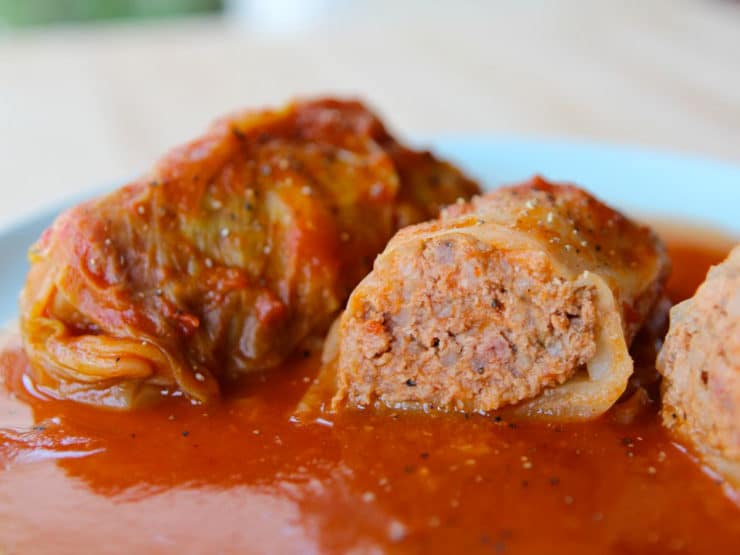
Step-by-Step: How to Make Stuffed Cabbage Rolls (Holishkes)
-
- Soften the cabbage. Rinse the cabbage, and immerse it in a large pot of boiling water until the leaves are soft and pliable. Then, drain the cabbage in a colander and set it aside to cool.
-
- Prepare the filling. Mix all the filling ingredients in a large bowl. Then, adjust the seasonings if needed.
-
- Roll. Place whole cabbage leaves on a cutting board, and pat them dry with a paper towel. Use a paring knife to shave the tough, thick part of the stem. Then, place about 1/4 to 1/3 cup of filling, depending on the size of each leaf, in the center of the cabbage. Fold the base of the leaf up, covering the filing. Then, fold the edge inward and tuck the loose leaf inward, creating a pocket. Repeat, rolling all the leaves.
-
- Heat. In a small saucepan, combine the tomato sauce, diced or crushed tomatoes, lemon juice, brown sugar, and spices. Warm over medium heat until bubbling and fragrant. Then, season to taste.
-
- Combine. Add sauerkraut and chopped cabbage to the bottom of a pot, and spread the mixture out in an even layer. Pour broth on top, and place half of the stuffed cabbage leaves over the mixture, placing them seam side down. Next, layer the tomato sauce on top, and repeat with the remaining cabbage leaves and sauce.
-
- Cook. Bring the mixture to a gentle boil over medium-high heat. Then, reduce the heat to a slow simmer, cover the pot, and cook until the cabbage leaves are tender.
-
- Serve. Carefully remove the cabbage from the pot. I like to use tongs for this! Then, spoon some of the sauce on top, add a generous sprinkle of black pepper, and serve hot.
We are a participant in the Amazon Services LLC Associates Program, an affiliate advertising program designed to provide a means for us to earn fees by linking to Amazon.com and affiliated sites. As an Amazon Associate I earn from qualifying purchases.

Stuffed Cabbage Leaves
Ingredients
- 1 large green cabbage (3.5-4 lbs.)
- 1 pound ground beef, ground chicken, or a mixture (I use half and half)
- 1 cup cooked long grain rice, white or brown
- 1/3 cup finely minced onion
- 2 tablespoons fresh minced dill
- 1 large egg
- 1 1/2 cups sauerkraut divided
- 28 ounces tomato sauce, divided (2 cans)
- 14 ounces diced or crushed tomatoes (1 can)
- 2 tablespoons fresh lemon juice or more to taste
- 2 tablespoons brown sugar or more to taste
- 2 tablespoons tomato paste
- 1 tablespoon paprika
- 1 clove garlic minced
- 1/4 teaspoon allspice
- 1/2 cup chicken stock or water
- Salt and pepper to taste
Instructions
- Rinse the cabbage clean, then immerse it in a large pot of boiling water and cook it for 4-5 minutes until leaves are soft and pliable, but not overly soft.

- Drain the cabbage in a colander and let it sit until cool enough to handle.

- Alternatively, you can freeze the cabbage overnight (or up to 3 days). Defrost the cabbage for about three hours. This will make the leaves pliable in the same way that parboiling does.

- Prepare your filling. In a bowl, mix together ground meat, cooked rice, minced onion, minced dill, egg, ½ cup sauerkraut (drained of juice), 1/3 cup tomato sauce, salt and pepper to taste. I use roughly 1 tsp of salt and 1 tsp pepper—kosher meat needs less salt. To test the seasoning of the meat, you can fry up a small portion in a skillet or pop it in the microwave until it’s thoroughly cooked, then taste it. It’s easy to under-season the filling, so err on the side of adding seasoning. Alternatively, if watching your sodium, you can add much less salt during this step, and season the finished dish to taste.Tip: You can make this filling ahead and refrigerate a few hours to overnight; this will allow the flavors to marinate and make it firmer and easier to handle.

- Peel off the large cabbage leaves from the head of cabbage, keeping only the leaves that are whole/intact and big enough to stuff. Chop up the remaining smaller leaves along with the core of the cabbage. Reserve.

- Place your large leaves on a cutting board.

- Take a leaf and pat it dry with a paper towel.

- Shave down the tough, thick part of the stem at the base of each leaf using a paring knife, being careful not to cut through the leaf itself. Repeat process for the remaining leaves.Now it’s time to stuff the leaves. Place a leaf on the cutting board, stem end closest to you. The leaves tend to curl in one direction, so make sure that the curl is facing upward—in other words, it should have a bowl-like shape with edges that curl up, not down.

- Place 1/4 to 1/3 cup of filling at the base of the leaf, centered, about 1/2 inch above the edge. Do not over-stuff the leaves; you want a substantial amount of filling, but a good amount of cabbage leaf around the edges makes for easier rolling.

- Fold the base of the leaf up and over the filling until it’s completely covered.

- Fold the left edge of the leaf inward. Leave the right side of the leaf open.

- Continue rolling the leaf until it’s completely rolled up (with the right end still loose/open).

- Tuck the loose end of the leaf inward, pushing it into the filled center of the leaf.

- This will create a neat package that has a better chance of holding together in the pot.

- Continue this process for the remaining leaves. Depending on how many useable leaves your cabbage has, you may find you have some leftover filling. Simply roll that filling into meatballs; you can place them into the pot along with the stuffed leaves, so you don’t waste anything.

- In a small saucepan, combine the rest of the tomato sauce with the diced or crushed tomatoes, lemon juice, brown sugar, tomato paste, paprika, garlic and allspice. Warm up over medium heat until bubbly and fragrant. Taste the sauce; season with salt and pepper and more brown sugar or lemon, if desired.

- Put remaining 1 cup of sauerkraut and the chopped cabbage leaves/core into the bottom of a pot. Spread the mixture out to create an even layer, then pour ½ cup of chicken broth or water over the top of the leaves.

- Place half of the stuffed cabbage leaves on top of the sauerkraut mixture.

- Pour 1/3 of the warmed tomato sauce over the first layer of stuffed cabbage leaves.

- Put another layer of stuffed leaves on top...

- ...and top with the rest of the sauce.

- Heat the pot over medium high and bring the sauce to a gentle boil. Reduce heat to a slow simmer and cover the pot. Let the cabbage leaves cook for 2-2 ½ hours until the thickest parts of the leaves are tender. Check the pot periodically to make sure it’s not boiling too vigorously—this can make the leaves fall apart. A slow, even simmer works best.When finished cooking, remove the stuffed cabbage leaves from the pot carefully with tongs. Top the stuffed cabbage with some of the sauce and a very generous sprinkle of black pepper. Serve hot. Leaves can be refrigerated for 4-5 days or frozen and reheated before serving.

NOTES
Nutrition

tried this recipe?
Let us know in the comments!
If you enjoyed this recipe, I’d love it if you left me a star rating and comment below. Also, don’t forget to share and tag us on Facebook and Instagram!
FAQs
I like to serve Jewish stuffed cabbage leaves with a starchy side like olive oil mashed potatoes, classic potato latkes, or smoked paprika potatoes. They’re also great with Borscht or matzo ball soup. Or, for a light meal, I pair them with Israeli salad or a crunchy pickled salad.
Yes, I find that leftover stuffed cabbage leaves keep fresh in an airtight container in the fridge for 4-5 days. Or, you can also store them in the freezer for up to 2-3 months. To serve, thaw in the refrigerator overnight. Then, reheat in the oven, microwave, or in a large skillet over medium heat.
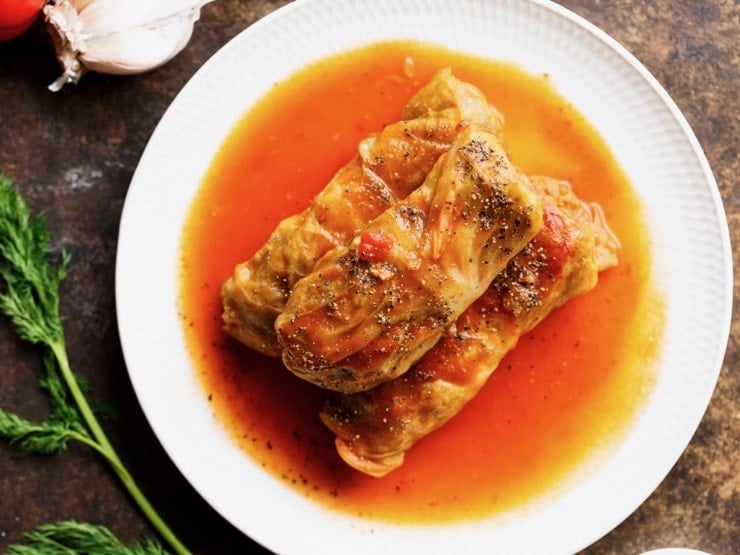


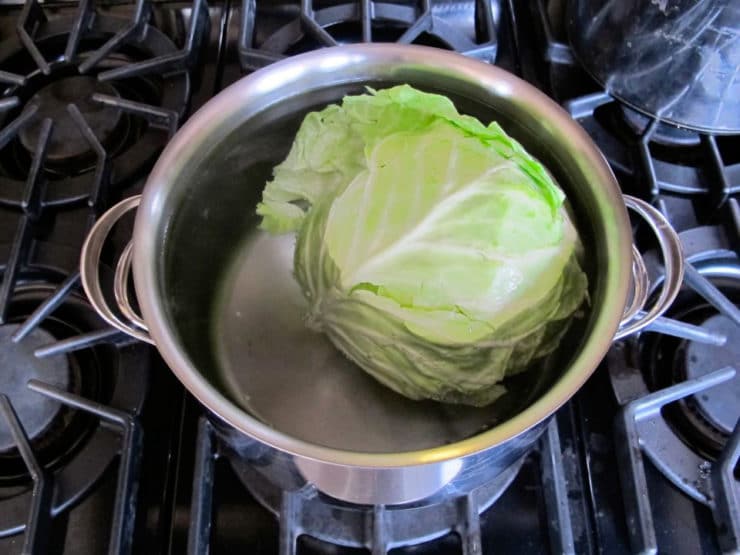
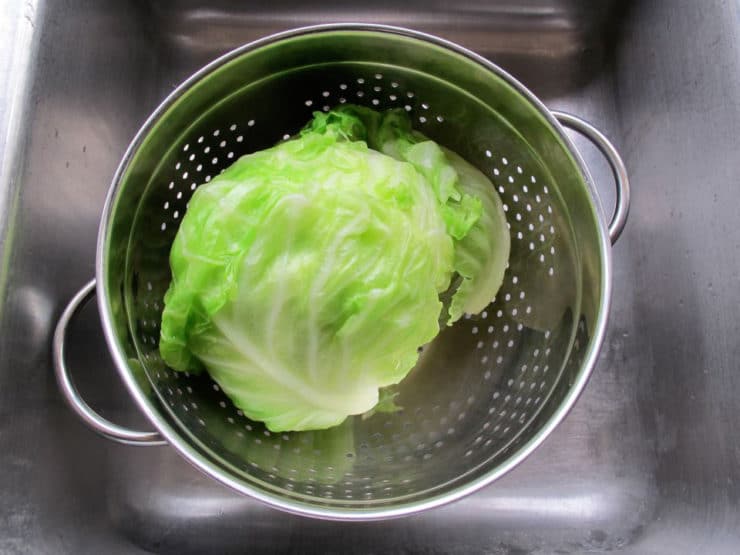
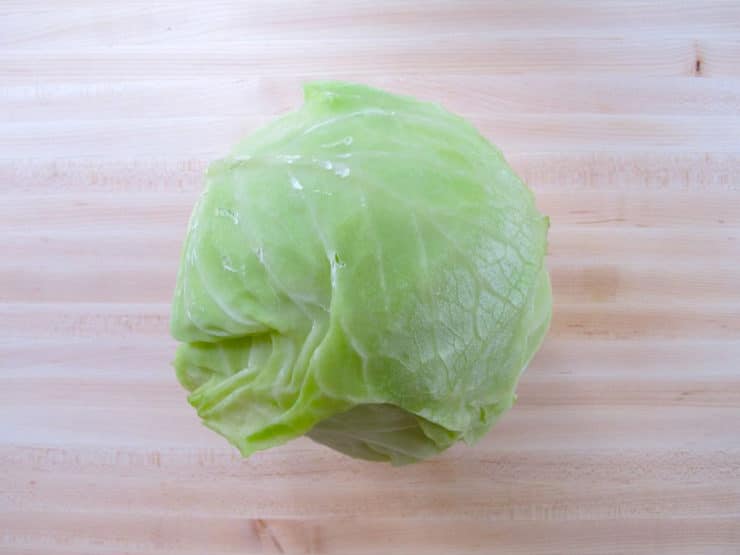
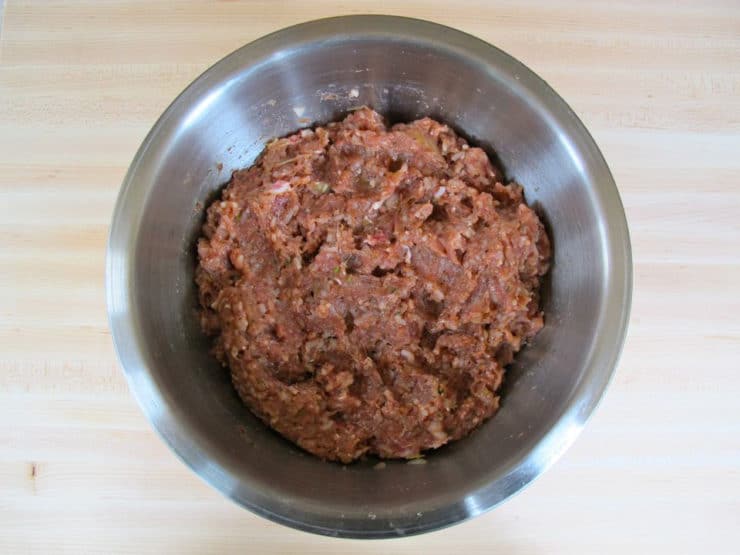
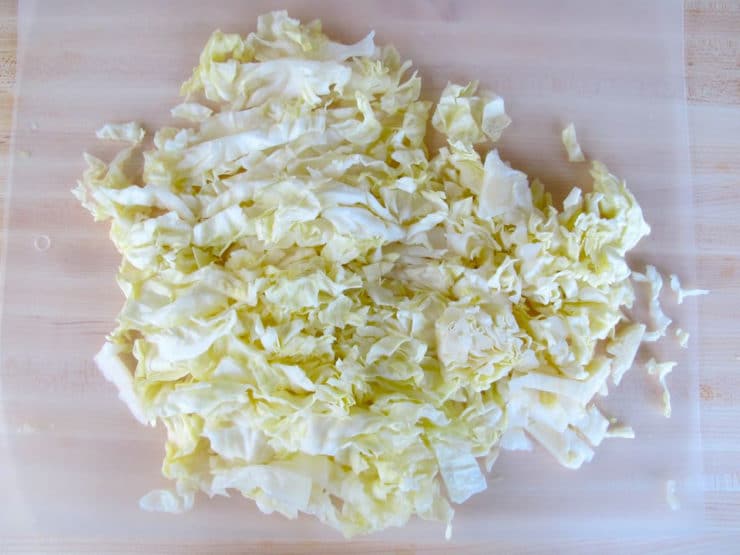

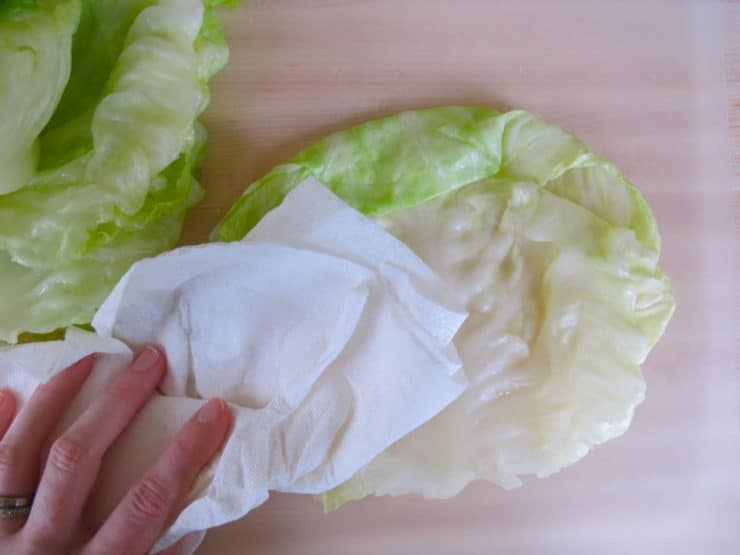


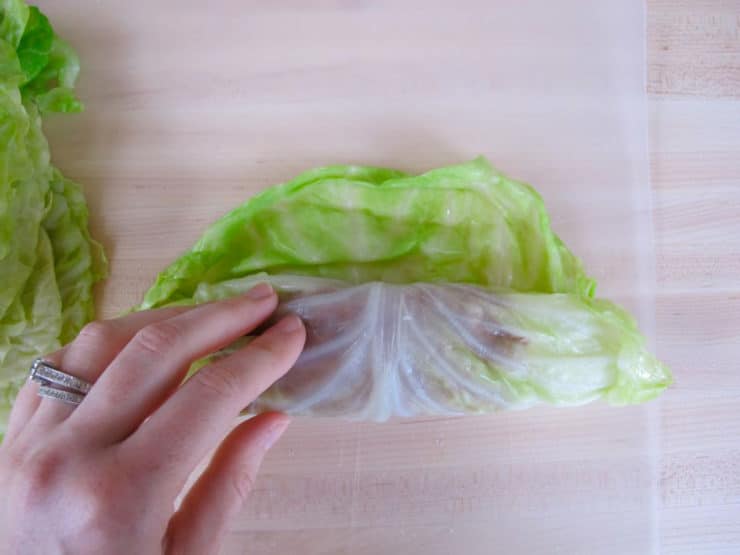

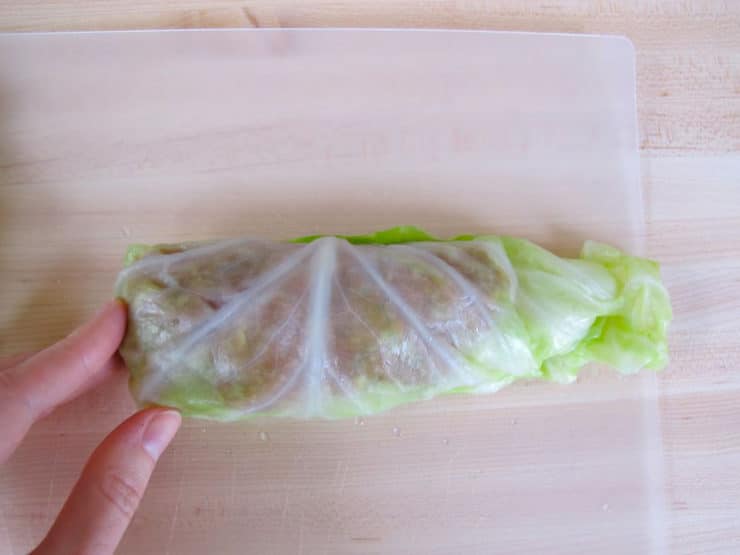
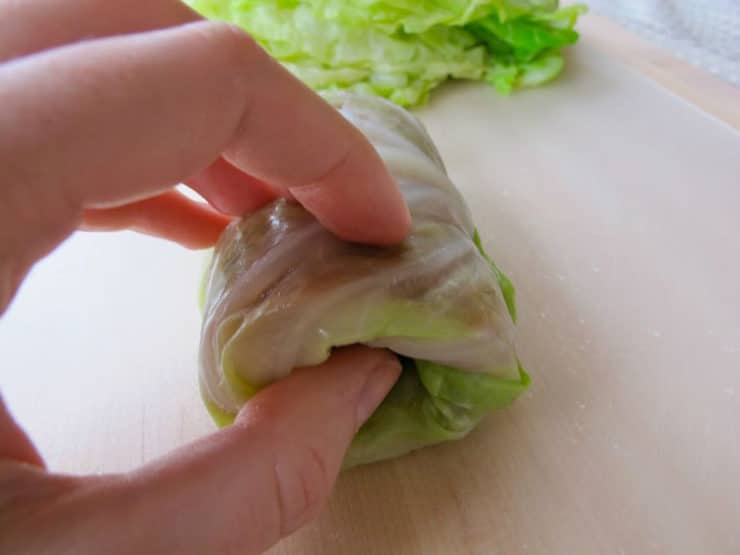
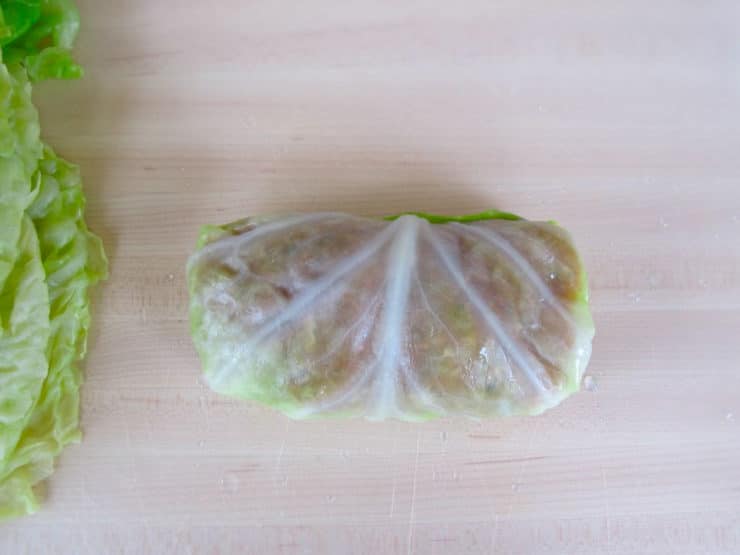

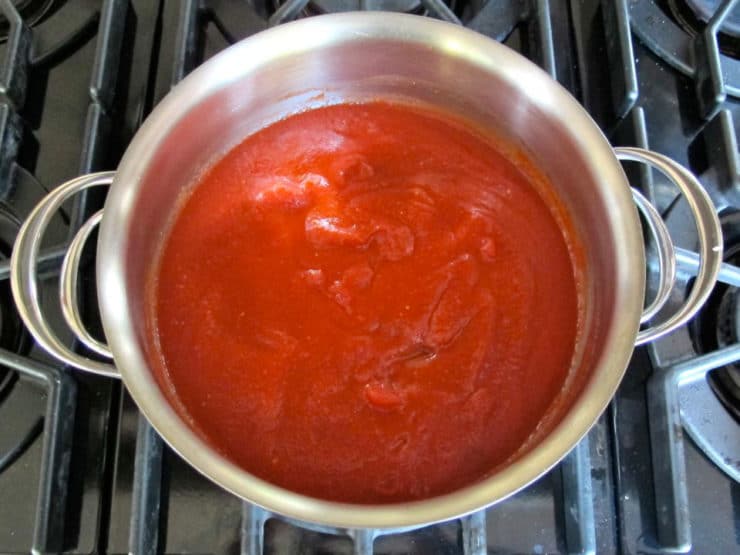
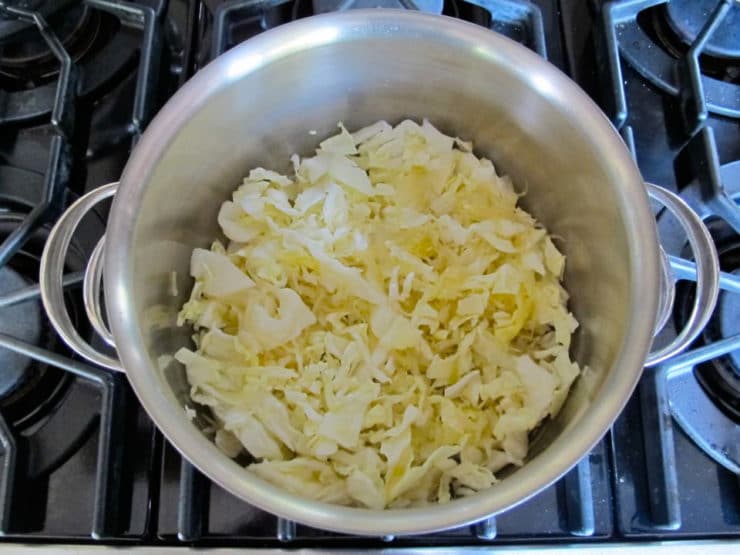

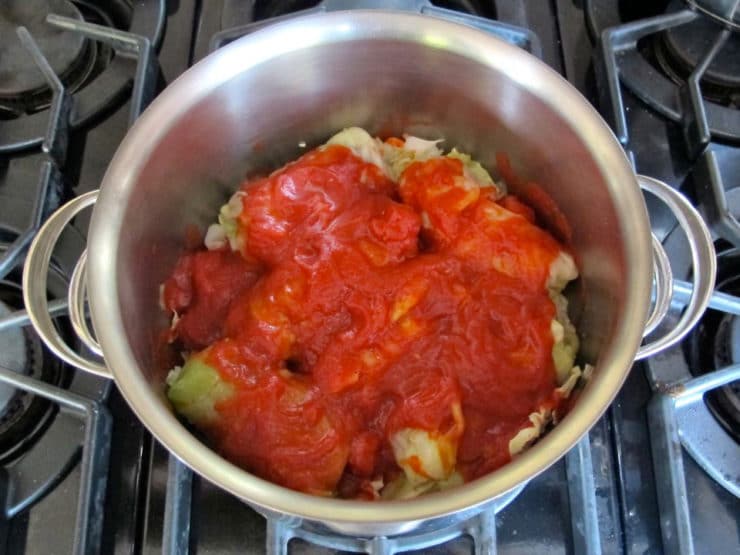
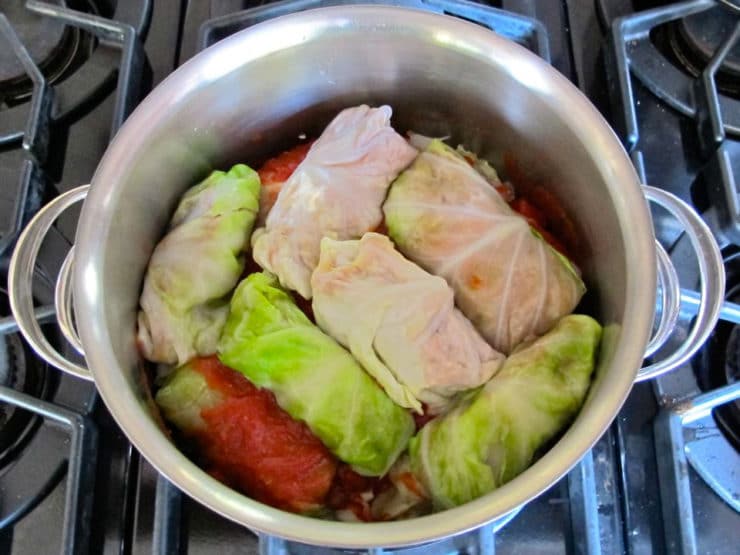
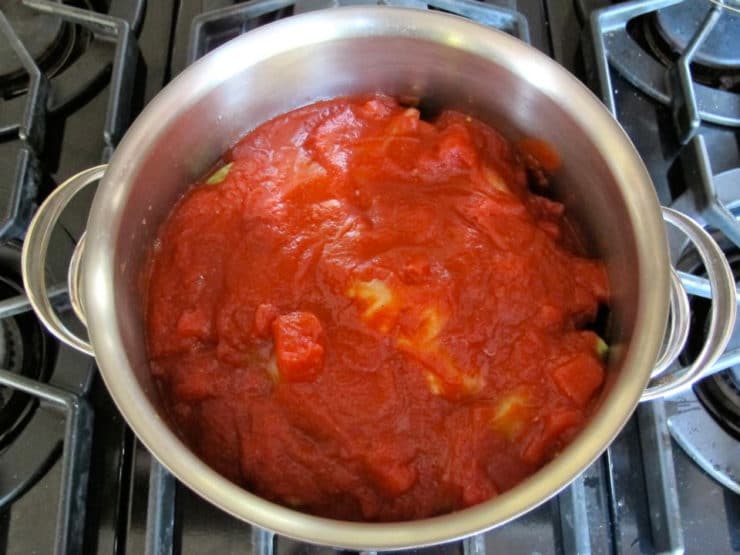


I follow my Yiddishe Mama’s version (she came from the Soviet Union but learned to cook here)–
Sour salt-scant teaspoon
Grape jelly 2-3 tablespoons
Chile Sauce – 1 bottle
Tomato soup
Golden Raisins
I use ground sirloin, and also, I start by preparing a beef broth.
I’m making them right now—yum.
My Grandmother’s slovakian recipe is similar with the “meatloaf mix” filling but we definately had the tomatoes and added sauerkraut and either polish or spicy hungarian sausage, as well as a few stuffed green peppers to the pot!
I grew up eating the stuffed cabbage made by my Slovenian American mom, who grew up in Cleveland, which sounds very similar to what Bonnie posted above. (Maybe she’s a member of our tribe 🙂 But after many years of marriage to a Jewish man, and lots of Ashkenazi cooking, I’ve grown more accustomed to that sweeter style. But it’s all good! Now I’m back to exploring my Slovenian roots through cooking. Great blog!
I too, love stuffed cabbage! But my family (half Polish, half Russian) made them different than any other recipe I have ever found. The making of the rolls themselves is all basically the same. The filling is what up in northern Ohio is called “meatloaf mix” which is ground beef, ground pork and ground veal. So, its the meatloaf mix, uncooked rice, chopped onion, garlic, dried parsley, salt and pepper. The rolls are wrapped using boiled cabbage leaves. The rolls are layered in a pot or electric roaster (thats how my moms sister cooked them). They are layered with chopped cabbage and sauerkraut. All mostly the same. But here is where my family differed. No tomatoes at all were added. A little water was added to the pot, and then just slow cooked. When the rolls were done, and there was a goodly amount of natural juice in the pot, we then make a zapraska, or roux. The zapraska is thinned with the juice from the cooked rolls, and then to this (basically, a white sauce) is added sour cream. Then this absolutely fabulous tasty gravy is poured over the rolls, and the rolls and their juicy sourcreamy gravy is served with mashed potatoes. The first time I had stuffed cabbage with tomatoes on them, I didnt know what they were. I still really only like them the way my family made them. Where my grandmother came up with that recipe, I have no idea. But it is the absolutely best way to eat them!!
Bonnie, my Nana used a similar meat mix and did not use tomatoes either. However she stuffed the whole head of cabbage. I never knew what the gravy was, but you may have found it for me.
Wow, I can’t believe there is all this cabbage rolls talk and no real comment on the real cabbage – soured! I am an American who went to live in former Yugoslavia in the time of communism and am now in Japan. I learned from the locals in Croatia, just over the hill from Slovenia, how to make the real thing. There is no taste like what soured cabbage gives. It is no more than sauerkraut but the whole head is the sauerkraut! Because I am not in Europe, I have to make the heads of cabbage sour in my Japanese kitchen. I scoop out the beginning of the stem part, fill it with salt to about two inches down, and put the heads down in a new trash bin and cover with water. I add a little more salt to do the job. The heads are pushed down under the water so they do not spoil in the pickling process. Plastic bottles filled with water over a firm object to keep the heads under are a good way to get the weight needed to keep them under. Put the lid on top of the plastic container. After two weeks you can surely smell that they are in a procedure of change! After two months they are ready to pull out and are naturally soft and pliable. They are now ready to use in all of the above instructions. I started late this year after cold set in so they have been sitting in my kitchen the last two weeks where it is warmer. They are now ready to put in the covered outside to continue fermenting. Japan is not as cold as Europe so they can be in an outside area rather than in a cold basement. They are good all winter. In the Spring what is left can be placed in the freezer for Spring ad Summer use. Try it and you will see the difference!
During the pickling process is the cabbage in the refrigerator?
The way I interpret what you wrote makes it sound as tho the cabbage is simply sitting in the kitchen or somewhere for the whole time it is pickling. Please reply back as I feel as tho I must be reading this wrong.
Harold,
I ferment and pickle all the time. The fermentation process is done at room temperature. Though if you are uncomfortable with that, it can be done in the fridge it just takes a LOT longer, and I wouldn’t use heads whole for that method. The key is the salt and keeping the cabbage fully submerged.
I love (p)brokes. The only real differences in the recipes from yours is that my grandmother used sour salt to give it its zest and she used uncooked rice and let it cook in the meat juices so that it wasn’t too watery.
Either way…………….I make it all the time!
Our family recipe is very similar. My mom and grandma use a combination of ground beef and ground pork sausage.
Love cabbage rolls!
I love stuffed cabbage. We have a Vietnamese version of it as well. Your post is great showing the step-by-step to make it! Love it with such vivid and vibrant coloured pictures. Would you mind if I mentioned it on my blog post for my stuffed cabbage recipe? I would also love to tweet about it 😉
Thank you for sharing!
My Nana always made us the Polish version of stuffed cabbages. I live in a remote village in Alaska now. I had the good fortune of having all the ingredients to make this wonderful dish. I enjoyed reading all the comments on this topic on your blog. The last time I made stuffed cabbages, I did include “delish salt” which was citric salt. I think the vinegar in my recent venture with this recipe worked really well. My recipe is on the sweeter side, but not overly sweet. Here it is…
http://donachyblog.wordpress.com/2011/11/20/warm-memories-of-savory-stuffed-cabbages/
P.S. I will be tackling some of your other recipes on your site. Thanks for sharing.
Barbra Donachy
Superb recipe!
Tori, I made your cabbage rolls and they were fantastic! I saw the photos you posted (was drooling), and with the weather getting chilly, figured it was the perfect dinner to make and it was! Thank you for posting it, and all your other fabulous recipes. I have made several of them and they have all been winners!! Your ‘audience’ always provides such great tips, ideas and suggestions in their feedback too! I learn a lot from them!
I’m so happy you enjoyed them Sally!
I make stuffed cabbage once or twice a year, but I make three large heads at once. I feed my family, my daughter-in-law takes some home for the next day, and I eat it again the next day. Then I freeze the rest in a few containers to enjoy at other times during the year. The thing I learned today is about freezing the cabbage first. I’d never heard that before and I’m definitely going to try it because I have to boil the cabbages a whole lot longer than five minutes, and there’s a lot of cabbage. Having it defrosted and ready to stuff would be a great help. Thanks for the tip. Your website is great.
This looks so good. I’ve actually never had these so must add them to the list of must makes. Your broadening my horizons Tori. And I love you for it!!
I love stuffed cabbage leaves, I make a veggie version with rice, feta, raisins, almonds, mint and cinnamon. You’ve just reminded me, it’s going on my list for this week, thanks!!
Others have mentioned “sour salt” which my mom…and her mom, who was from Lithuania….insisted was the best. “Zoyer Zalts” which as was mentioned earlier is citric acid. My dad was a pharmacist and would bring home “pharmaceutical grade” zoyer zalts. Thanks for the recipe.
Yours look wonderful. You have an interesting way of sealing the second end, I will have to try that. My Bubbe used sour salt and sugar for all things sweet and sour. And raisins in her chalupches. And she used uncooked rice and lo! it always turned out cooked. Go figure. Try and find sour salt today!
We have a similar Turkish cabbage dish as well, similar filling. I also heard from another Turkish lady that there is a chestnut filling version without the meat… This brings back memories 🙂
Your stuffed cabbage is beautiful. I make it as well. My mother also made the dairy version and stuffed it with rice, raisins, chopped apple, a little sugar, an egg. Every thing else the same. So good.
these look wonderful. I love stuffed cabbage. well done Tori
My grandmother passed away before I could try her cabbage rolls. A friend of hers made them once for me when we were home visiting family. My grandmother was from Slovenia and she called them Pigs in a Blanket. (There must have been pork in the rolls?) My partner’s family is from Poland and she makes them very close to your recipe. She uses hamburger and turkey. Thanks so much for the post! I LOVE hearing about other families versions of classic dishes. Ever hear of potica? That’s another family traditional food of my families. It’s a thinly rolled sweet bread with a walnut filling. Very delicious – very Eastern European.
My grand parents came from Poland and Russia so we had similar versions of this great comfort food. Does any one have a recipe for what my Aunt Ettie (from Poland)called “onion cookies”? They were really a savory biscuit that contained flour, corn meal, and poppy seeds. I’ve never had them from any one else.